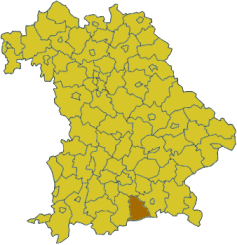Miesbach (district)
| Miesbach | |
|---|---|
| District | |
 | |
| Country |
|
| State | Bavaria |
| Adm. region | Oberbayern |
| Capital | Miesbach |
| Area | |
| • Total | 864 km2 (334 sq mi) |
| Population (31 December 2015)[1] | |
| • Total | 98,286 |
| • Density | 110/km2 (290/sq mi) |
| Time zone | CET (UTC+1) |
| • Summer (DST) | CEST (UTC+2) |
| Vehicle registration | MB |
| Website | landkreis-miesbach.de |
Miesbach is a district in Bavaria, Germany. It is bounded by (from the west and clockwise) the districts of Bad Tölz-Wolfratshausen, Munich and Rosenheim, and by the Austrian state of Tyrol.
History
In medieval times most of the district was occupied by clerical states. The Miesbach district is the union of the areas that were formerly occupied by the Hohenwaldeck county, the territories owned by the powerful Tegernsee Abbey, the territories owned by the Weyarn Abbey and Valley County.
Hohenwaldeck was annexed by Bavaria in 1734, Valley in 1777. The clerical states were dissolved in 1803 and fell to Bavaria as well.
Miesbach was established in 1803 the foundation ceremony took place in the court district of Hohenwaldeck.
In 1818 Tegernsee was established. The same year the Bad Aibling district was established too and Miesbach had to deliver 12 municipalities.
In 1939 Tegernsee was merged into Miesbach. During the territorial reform in Bavaria in 1972 Otterffing was merged into Miesbach too and the district Wolfratshausen as well.
Geography
The southern half of the district is located in the Bavarian Alps. This section of the Alps is called Mangfall Mountains (Mangfallgebirge) as the River Mangfall has its source here. The most important peaks are Rotwand ("Red Wall", 1884 m), the highest mountain in the area and Wendelstein (1838 m) .
The Mangfall River, a short but broad affluent of the Inn River, flows northward with the district's municipalities on either bank. In the initial part of its course it runs through Tegernsee Lake (9 km²).
Coat of arms
 |
The coat of arms displays:
|
Government
| Charge | Name | Years in office |
|---|---|---|
| District Minister | Franz Xaver Steyrer Max Graf von Preysing Joseph Wiesend Wolfgang Knorr Alois Schmid Carl Bollweg |
1803–1806 1806–1813 1813–1846 1846–1848 1848–1851 1851–1862, 1874 |
| Joint President | Carl Bollweg Ludwig Mayr Uhl Carl Riezler Bernhard de Rudder Hermann Kopp |
1851, 1862–1874 1874–1888 1888–1890 1890–1911 1911–1929 1929–1938, 1943 |
| District Administrator | Kemnitzer Dr. Frick Dr. von Wehner Schindler Friedrich Roith Freiherr von Schoen Friedrich Roith Dr. Süß Meissner Dr. Simon Beck Anton Bauer Dr. Walter Königsdorfer Wolfgang Gröbl Norbert Kerkel Jakob Kreidl Wolfgang Rzehak[2] |
1943–1944 1944–1945 May 10, 1945 – August 1, 1945 August 1, 1945 – May 10, 1946 May 11, 1946 – May 27, 1946 May 28, 1946 – June 11, 1946 June 11, 1946 – September 25, 1946 September 26, 1946 – May 31, 1948 June 5, 1948 – December 14, 1948 1949–1951 1952–1955 1955–1972 1972–1987 1987–2008 2008-2014 since 2014 |
Towns and municipalities
| Towns | Municipalities | |
|---|---|---|
References
- ↑ "Fortschreibung des Bevölkerungsstandes". Bayerisches Landesamt für Statistik und Datenverarbeitung (in German). June 2016.
- ↑ Landrat Wolfgang Rzehak, District Miesbach
External links
| Wikimedia Commons has media related to Landkreis Miesbach. |
- Official website (German)
Coordinates: 47°45′N 11°50′E / 47.75°N 11.83°E